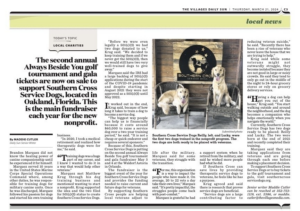
ALWAYS BESIDE YOU – INAUGURAL GALA 2023
-
by
Matthew Krug
Southern Cross Service Dogs was founded to enable an enriching and fulfilling life by pairing exceptionally trained service dogs with exceptional people to provide an increase in independence and self-reliance.
Why Southern Cross?
The Southern Cross name and design pays homage to the
United States Marine Corps Raiders. The Southern Cross star
constellation represents the historic achievements of the Marines
serving during the Pacific campaign of WWII, specifically those
actions on Guadalcanal. The Marine Corps Raiders were active
from 1942 to 1944. On June 19, 2015, The Marine Corps Special
Operations Command formally recognized and redesignated the
organizational units as Marine Raiders. The present-day brave
men and women of the Marine Raider’s bestow upon them the
Raider insignia of a closed skull surrounded by the Southern Cross
Star Constellation.
Southern Cross Service Dogs was founded with traditions and
unity in mind. Our Founder Brandon Marquez spent seven
years as a Multi-Purpose Canine Handler for the Marine Corps
Special Operations, before being medically retired in January
2020. Choosing the name Southern Cross pays tribute to the
Marine Corps Raiders, past, present, and future.
Always Beside You
The overarching goal of Southern Cross Service Dogs is to
provide well-trained dogs that exemplify the motto,
“Always Beside You”. Service dogs bestow unconditional love,
offer steadfast support, provide unwavering companionship,
and perform specific tasks to help mitigate an individual’s
disability. Thus, service dogs become the bedrock for veterans
to cope with post-combat challenges, re-engage in the
community, manage emotional trauma, and reduce
post-traumatic stress (PTS) symptomatology.
Some of the demonstrable benefits of PTS service dogs for veterans include:
★ Ability to recognize and better cope with symptoms
★ Greater self-sufficiency
★ Decreased reliance on prescription drugs
★ Confidence to return to work or school
★ Reduced anxiety and stress
★ Reduced hyper vigilance
★ Improved sleep
★ Increased confidence to be in public
★ Restored sense of daily purpose
Why It Matters
★ There are 18.5 million veterans in the United States.
★ 1 in 3 Veterans have substantial post-combat mental health
challenges.
★ Approximately 20% of veterans suffer from symptoms of PTS.
★ On average 22 veterans commit suicide every single day.
★ It takes an average of 1.5 to 2.5 years to fully train a service dog.
★ Veterans are 1.5 times more likely to die by suicide compared
to non-veteran adults.
Everyone Should Know
Service dogs are individually trained to do work or perform
tasks for people with disabilities. Examples of such work or
tasks include guiding people who are blind, alerting people who
are deaf, pulling a wheelchair, alerting and protecting a person
who is having a seizure, reminding a person with mental illness
to take prescribed medications, calming a person with Post
Traumatic Stress (PTS) during an anxiety attack, or performing
other duties. Service animals are working animals, not pets.
The work or task a dog has been trained to provide must be
directly related to the person’s disability.
When it is not obvious what service an animal provides, only limited inquiries are allowed. Staff may ask TWO questions:
1. Is the dog a service animal required because of a disability?
2. What work or task has the dog been trained to perform?
Staff cannot ask about the person’s disability, require medical
documentation, require a special identification card or training
documentation for the dog, or ask that the dog demonstrate its
ability to perform the work or task.
A person with a disability cannot be asked to remove his service animal from the premises unless:
1. The dog is out of control and the handler does not take
effective action to control it.
2. The dog is not housebroken.
When there is a legitimate reason to ask that a service animal
be removed, staff must offer the person with the disability the
opportunity to obtain goods or services without the animal’s
presence.



